#Takashi Itō
Text

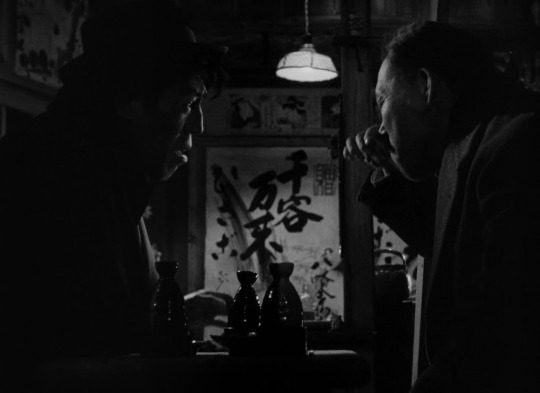
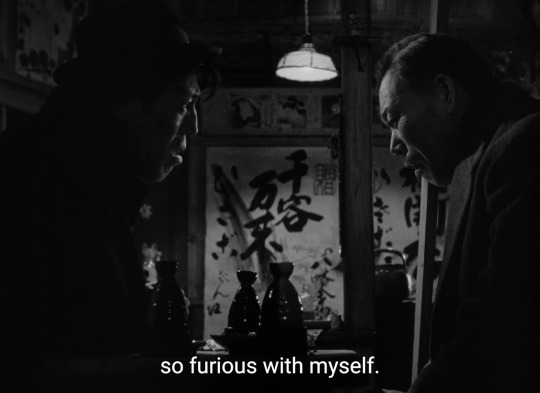
I'm just so furious with myself
#ikiru#akira kurosawa#To Live#takashi shimura#Kanji Watanabe#Yūnosuke Itō#scenephile#movie scenes#film quotes#film scene#movie scene
112 notes
·
View notes
Text
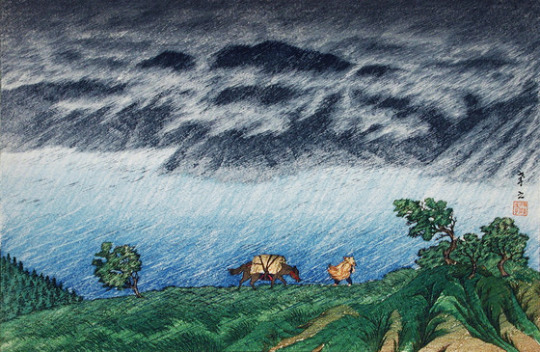
Ashinoko, View in Rain, by Itō Takashi, 1929, Japan.
92 notes
·
View notes
Text
Fan Casting for Danganronpa: Garden of Chaos
Hey, everyone.
While I'm working on the prologue of Danganronpa: Garden of Chaos, I decided to share with you my "fan casting" of the classmates/campers in this Killing School Retreat. It's so that when I write out the story, I can try and imagine their voices when they talk. Please feel free to comment your opinion if you have a better idea on who voices whom. And now, without any further ado, here are the Ultimates. (Spoiler alert for two of them):
Girls:
Setsuna Higurashi - Ultimate ??? (Super High School Level ???); later Ultimate Hope (Super High School Level Hope) Voiced by Cristina Valenzuela/Saori Hayami
Tsumugi Shirogane - Ultimate Cosplayer (Super High School Level Cosplayer) Voiced by Dorothy Fahn/Minako Komatsu
Hotaru Tsukasa - Ultimate Songstress (Super High School Level Singer) Voiced by Laura Bailey/Shizuka Itō
Nozomi Yashiro - Ultimate Ceramist (Super High School Level Potter) Voiced by Mae Whitman/Hisako Kanemoto
Minako Suzuki - Ultimate Super-Model (Super High School Level Model) Voiced by Brina Palencia/Sayaka Ohara
Ayaka “Lilith” Konishi - Ultimate Pet Sitter (Super High School Level Animal Caregiver) Voiced by Elizabeth Maxwell/Junko Minagawa
Keiko Ichihara - Ultimate Baker (Super High School Level Baker) Voiced by Erica Lindbeck/Rina Sato
Akari Tohsaka - Ultimate Figure Skater (Super High School Level Ice Skater) Voiced by Grey DeLisle/Kana Ueda
Boys:
Rantaro Amami - Ultimate Adventurer (Super High School Level Adventurer); later Ultimate Survivor (Super High School Level Survivor) Voiced by Johnny Yong Bosch/Hikaru Midorikawa
Eijiro Mitsumori - Ultimate Doctor (Super High School Level Doctor) Voiced by Zachary Gordon/Mamoru Miyano
Katsuki Inushima - Ultimate Huntsman (Super High School Level Hunter) Voiced by Max Mittelman/Toshiyuki Morikawa
Takashi Nanase - Ultimate Drill Sergeant (Super High School Level Drill Sergeant) Voiced by Benjamin Diskin/Eiji Takemoto
Yusei Kagehira - Ultimate Race-Car Driver (Super High School Level Racer) Voiced by David Gallagher/Yūki Kaji
Daisuke Yashiro - Ultimate Sculptor (Super High School Level Sculptor) Voiced by Clifford Chapin/Shōtaro Morikubo
Satoshi Rangetsu - Ultimate Pickpocket (Super High School Level Thief) Voiced by Zeno Robinson/Junya Enoki
Akira Takashina - Ultimate Secret Agent (Super High School Level Spy) Voiced by Robbie Daymond/Daisuke Kishio
2 notes
·
View notes
Text
"The Demon Girl Next Door": A Comedic Anime Worth Watching
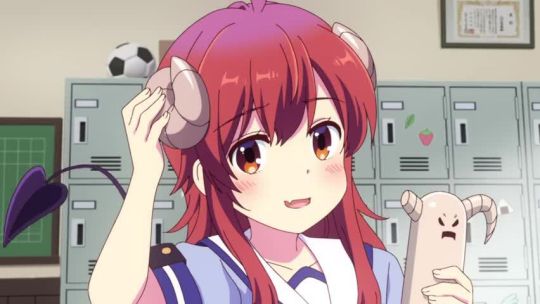
What if one day you woke up and were a demon? Yuko experiences this dilemma in The Demon Girl Next Door. She tries to get a hold of her new form and is tasked with defeating the local magical girl... but not everything is as it seems.
Reprinted from The Geekiary, my History Hermann WordPress blog (it will be published there on Dec. 20), and Wayback Machine. This was the thirty-ninth article I wrote for The Geekiary. This post was originally published on May 18, 2022.
The Demon Girl Next Door is a supernatural and magical girl anime directed by Hiroaki Sakurai. It is based on Izumo Itō's manga parody series, is also known as "Street Corner Demon", and is filled with comedic moments from beginning to end.
As a warning, this recommendation discusses some spoilers for the first 19 episodes of The Demon Girl Next Door.

Yuko begins transforming into her crisis management form
The Demon Girl Next Door, builds off the usual story, where someone wakes up and is different from who they were when they went to sleep. One day, Yuko Yoshida (voiced by Konomi Kohara) comes to the frightening realization that she has a tail and horns. She learns that she is the descendant of a demon cursed to live in poverty by an opposing clan.
In order to restore the clan's honor, her mother, Seiko Yoshida tasks her with defeating the local magical girl of the town, Momo Chiyoda. This is easier said than done. Yuko is assisted by her ancestor, Lilith, who is trapped in a totem, and occasionally by her sister, Ryoko Yoshida.
However, Yuko is beset with a dilemma after Momo (voiced by Akari Kito) saves her from certain death. This is made even worse when she realizes that Momo attends the same high school as her! Luckily, she is helped by her school friends Anri Sata (voiced by Sayaka Senbongi) and Sion Ogura (voiced by Ayaka Suwa). Some call her "Shamiko" or by her full name "Shadow Master Yuko."
Sion is into the occult as much as Yoshiko Tsushima in Love Live!! Sunshine! who believes she is a "fallen angel" named "Yohane" and Rie Maruyama in Cue! who calls itself a demon from hell named "Ellis."
The series shares many similarities with The Great Jahy Will Not Be Defeated!, where a powerful demon named Jahy lives in a ratty apartment and tries to gain all of the mana crystals to restore her powers. Yuko also lives on the edge of poverty with her sister Ryoko (voiced by Hitomi Ohwada) and mother, Seiko Yoshida (voiced by Sayaka Ohara).
Similar to the aforementioned series, in The Demon Girl Next Door Yuko becomes friends with Momo and her friend from another town, Mikan Hinatsuki (voiced by Tomoyo Takayanagi). In a unique twist, Mikan has been afflicted by a "guardian spirit" that attacks whenever Mikan's heart is racing, resulting in those around her to experience calamities. This is akin to the misfortune that the magical girl faces when she uses the mana crystals in The Great Jahy.
Later in the series, it is comically revealed that Yuko and Ryoko's father, Joshua (voiced by Hideyuki Umezu) was sealed inside a cardboard citrus box by another magical girl. It turns out that the family uses this box every day to cook their meals on a hibachi!
That magical girl is named Sakura Chiyoda (voiced by Hisako Kanemoto) and the stepsister of Momo. She disappeared ten years ago after she manipulated a sacred seal to ensure she stayed in good health. It later becomes Momo, Mikan, and Yuko's mission to find her. And she does appear in one of the show's most recent episodes. Mikan, on the other hand, has a familiar named Ugallu.
In another parallel with The Great Jahy, for some time Yuko begins working at a cafe run by a demon tapir named Shirosawa (voiced by Takashi Matsuyama) which has a chef and waitress named Lico (voiced by Ayassa Ito). Although Yuko goes there to garner information about Sakura, she becomes poisoned by the food, which makes her a work zombie, until she is saved by her more-than-a-friend Momo.

Mikan (left) gives Yuko (middle) a lemon while Momo (right) watches Yuko, and Yuko's ancestor sits on a nearby table
On the one hand, the series has plot lines focused on mindscapes, reminding me of scenes in The Owl House, Steven Universe, and Inside Job where characters travel inside the minds of other characters, either on purpose or by accident.
In fact, Sakura, another magical girl, helps Yuko out of her nightmare in the fifth and sixth episodes of the show's most recent season, appearing as a mirage of sorts. The audience also learns that Sakura sacrifices herself so that Yuko could live; a noble sacrifice.
This series also features main characters with cool magical transformations. This is coupled with comedy, which is integral to the show.
This is not an off-the-wall comedy like the hilarious three-season slice-of-life yuri comedy, YuruYuri, for which the protagonist complains about her lack of presence, even resulting in her becoming translucent at times. Neither is it like romantic comedies such as the currently airing Kaguya-sama: Love Is War and Love After Domination, or a recently-ended isekei comedy with transgender themes, Life with an Ordinary Guy Who Reincarnated into a Total Fantasy Knockout.
Instead, there is situational comedy either based around interactions between Yuko, her family and school friends, and family, or with her magical girl friends, Mikan and Momo. As a person who loves to eat sliced oranges as a snack, I have to give props to Mikan, whose family owns a fruit company, for constantly, and somehow, finding fruit. She slices up oranges and lemons and chomps on them when they hang out or brings fruit to eat while she is on the go. Are there any other characters who do this? I can't even think of one.
Even more hilarious is the fact that Mikan's hair color fits directly with her love of citrus, as it has the same color as an orange-dyed orange. It also connects with her bubbly, excitable personality and her orange-themed magical transformation.
The same can be said for Momo whose hair color is pink, a color often associated with "innocence and uncomplicated childhood", who has incredible strength and can quickly transform.
Unlike some other series, Momo has no interest in remaining a magical girl, feeling that having such power is too much responsibility for her. Yuko attempts to take advantage of this and recruit Momo as her "vassal." While Momo turns this down, she remains on friendly terms and there are hints in the season 2 introduction that she may go down that route in the future. All the while Yuko continues to declare "don't think this means you won" after Momo "defeats" Yuko in some way.
This is series is not unique in flipping generally understood values, like magical girls seen as "good" and demons as "bad." In fact, the 2017 supernatural slice-of-life and comedy anime, Gabriel DropOut, has angels act like demons, and demons act like angels. Helluva Boss has the demons act like jerks but be relatable and care about each other, while the angels are utter jerks who only care about themselves.
It is even a bit funny that Yuko's magical girl-esque transformation is called "crisis management". It gives her a somewhat scantily clad uniform akin to the lead in The Great Jahy, but it only slightly improves her abilities. This is different than Jahy, as it only helps her a little bit. Due to this, however, Momo helps train her on how to hone her abilities and improve herself. Instead of magical girls and demons fighting one another, they are both on the same side, working together for common goals.
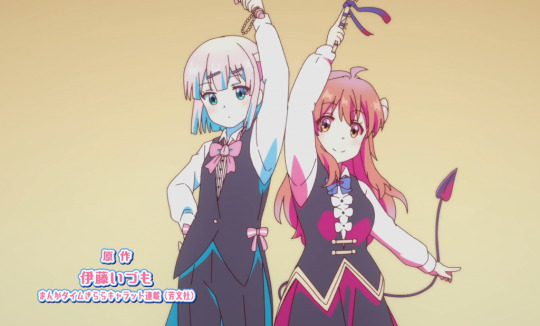
Image from the Season 2 opening of the two protagonists, Momo and Yuko
In the process, the series plays on the common magical girl elements, often associated with female interests like romance, femininity, and child-rearing, with cute appearances of characters resembling idol singers or princesses. When they are in their transformations, Momo, Yuko, and Mikan clearly transform into versions of themselves that seem more mature and prettier, with magical powers. However, Momo and Yuko have items that allow them to use their powers outside of their transformations.
Most powerfully, and apart from any other character in the series, Yuko has the ability to enter other people's minds. She does it often with a wand that sometimes transforms into silly items like a pen, a super-heavy trident, or anything else that does not help her in the slightest. She is also very expressive, with her demon tail telling as much about her emotions as the cat ears of Blake Belladonna in RWBY say about what she is thinking from minute to minute.
Yuko's demon features are often exploited by other characters, who hold her back by her tail, making it hard for her to move, or hold her horns like handles. This is even more painful than someone grabbing onto her tail.
I further found it funny that Yuko's younger sister, Ryoko, is more skilled with technology than her. In fact, she is just as skilled with technology as the underclassman angel Tapris in Gabriel DropOut.
At the same time, her ancestor, Lilith (voiced by Minami Takahashi), can be bought out of her totem into small forms which are like dolls. Hilariously, Momo can easily control her movements, angering Lilith, who is trapped inside the totem. She can only leave to occupy Yuko's body from time to time, which slightly changes Yuko's personality and even her tail in the process. Similar to many characters, she has a weakness for alcohol, which makes it easy to subdue her.
youtube
Although there is a goal for magical girls to have romance that leads to marriage, it is unlikely this would happen in The Demon Girl Next Door. No notable male characters appear in the series. Although Yuko and Momo seem to have some feelings for each other, it is unlikely that Yuko and Momo would marry one another.
In later episodes, they will likely become even closer. After all, in the most recent episode, she became Yuko's vassal (temporarily) and came over the the "dark side", nicknamed "Darkness Peach" by Mikan, to save her from a nightmare. In an unexpected twist, she becomes a dual-class holder whose physical class is light while her spiritual class is light. They both agree to work together to protect the city.
Rather, these characters could be shown ambiguously together and walking off into the sunset akin to the end of Charlie Chaplin's Modern Times. It is even less likely that there would any possible marriage, like that hinted between office worker, Kobayashi, and a dragon girl, Tohru, in the final episode of Miss Kobayashi's Dragon Maid.
All in all, The Demon Girl Next Door is a must-see, especially for those interested in demons, magical girls, and supernatural comedies.
The series is currently streaming on HIDIVE. The next episode will air on May 26, 2022.
© 2022-2023 Burkely Hermann. All rights reserved.
#the demon girl next door#anime#comedy#magical girls#demons#gabriel dropout#alcohol#modern times#miss kobayashi's dragon maid#hidive#yuruyuri#the great jahy will not be defeated#Youtube
8 notes
·
View notes
Text
Animation Night 113: Belle
Hi friends, happy Thursday!
It’s going to be a short animation night tonight, since I’ve got an art piece to urgently finish for a fan exchange. But since we didn’t manage to watch it back on Animation Night 107, tonight we’ll be watching Mamoru Hosoda’s film Belle to really give the video encoder a workout.

So, let me quote what I wrote about it last time:
The occasion is of course the release of Hosoda’s latest movie Belle (竜とそばかすの姫, Ryū to Sobakasu no Hime - lit. The Dragon and the Freckled Princess). This film reprises a theme that was very prominent in Hosoda’s early films such as Summer Wars and in fact the franchise film Digimon Adventure: young people going into an immersive digital world. It’s finally escaped the film festivals and, of course, landed in the hands of fansubbers.
(...)
Then at last we have Belle - once again coming to a digital world, this time just slightly more than ten years on! Hosoda’s latest film follows a seventeen-year-old girl Suzu who lost her ability to sing after the death of her mother, but rediscovers her passion for performance as an avatar in a colourful virtual world. Here, she gets drawn into the intrigue surrounded by a mysterious figure called the ‘Dragon’ after he disrupts one of her concerts. This time, the digital world spills out into the real in a different way: a vigilante named Justin starts threatening both Suzu and the ‘Dragon’ with doxxing, essentially.
The film is notable for being one of Hosoda’s first films to make heavy use of CG; the scenes inside the virtual world use 3DCG to attempt to hit that sense of overwhelming spectacle, while more usual usual cel animation is used outside. It also breaks a little from strict kagenashi with some use of digital compositing and filters, although the designs still carry that familiar simplicity and direct, childlike appeal. This change proved a little controversial for fans of Hosoda, and I’m going to be interested to see how well it holds up…
I should correct myself a bit here: Hosoda has worked in 3DCG on another digimon film... and also in another short film associated with the venerable GeGeGe no Kitarō series. That series began life before manga was even a thing in 1933, as a kamishibai called Hakaba Kitarō (墓場奇太郎) written by Masami Itō and illustrated by Keiyō Tatsumi.
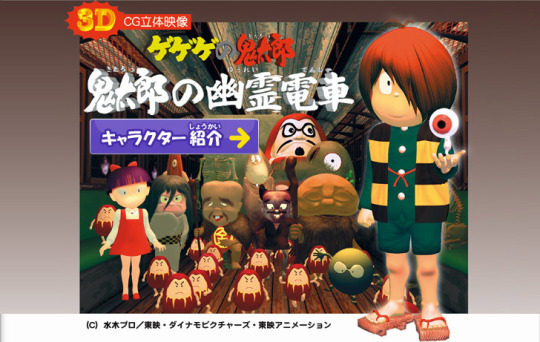
Decades later, with a world war in between, it became a manga by Shigeru Mizuki. At first deemed too scary for kids, it found a home in shōnen magazine and a whole series of others, before eventually landing in with one of the oldest TV anime, first adapted by Toei in 1968 just a few years after Astro Boy, where it became a big part in helping to re-popularise the concept of yōkai in modern times.
Since that point, it continued to get another five new series and a few films at intervals of years to decades - the basic premise of graveyard-dwelling Kitarō, last of the ‘ghost tribe’, encountering various mythological monsters from not just Japan but other countries such as China proved very flexible!
Hosoda’s entry came in 1999, released within a month of his Digimon short film that we viewed last time. It was a short 3D film called ゲゲゲの鬼太郎 鬼太郎の幽霊電車 GeGeGe no Kitarou: Kitarou no Yuurei Densha (Kitarou’s Ghost Train), and it’s not exactly easy to acquire; the only wide release came from a DVD called CG Toei Animation Festival which is not exactly widely available. The same, unfortunately, seems to be true of his CG Digimon short, which was on the same DVD. I have been able to find a couple of torrents of it on nyaa, but none seem well seeded, so if anyone has any ideas how to track it down I’d be all ears.
The other piece of Hosoda CG, much more relevant to Belle, is his short advert film Superflat Monogram with Takashi Murakami - yes, the superflat guy himself! This film is designed to promote the French fashion brand Louis Vuitton, who had a Murakami-themed collection; Hosoda worked on it right after his departure from Ghibli and shortly before Baron Omatsuri and the Secret Island (and on that front, lemme link kVin’s article again). The result was this short film, in which a girl outside a clothing store suddenly falls into an elaborate fantasy world...
youtube
This has what may by now be familiar Hosoda motifs for a virtual/fantasy world: a white void, big circles, lots of particle effects. As far as superflat goes, we can certainly see Hosoda’s characteristic flat kagenashii (unshaded) designs on his characters, but as for how it fits into Murakami’s broader ‘superflat’ project, I don’t really have time to dig into tonight. In any case, it demonstrates a combination of 3DCG for the setting and traditional animation for the protagonist girl, so we might even consider it a prototype for Belle in a way.
So tonight: keeping things short and sweet. I’ll show you Belle, and a couple of little Hosoda tidbits like the CG digimon film and Superflat Monogram. We’ll be on Picarto.tv/canmom again at about 8pm UK time (20 minutes), and after the film ends I’ll go straight into an art stream hope to see you there either way!~
11 notes
·
View notes
Text
Ikiru (1952)

Few works of art have the power to single-handedly change those who see them. Most only contribute to a lesson learned over time. Ikiru is the kind of reality-shattering story that should be mandatory viewing, particularly if you work in an office or are in a position to say “yes” or “no” to proposals. It’s a masterpiece that hasn’t aged a day since its release in 1952.
Kanji Watanabe (Takashi Shimura) has worked in the same monotonous office position for nearly thirty years when he learns he has stomach cancer and less than twelve months to live. Suddenly confronted with his mortality, he attempts to make up for the time he wasted.
Ikiru does what you expect it to and then goes deeper. After learning they have less than a year left, most people would probably find (or try to find) comfort in family and friends - or more likely indulge in fleeting pleasures like food, drink, drugs, or sex. Ikiru isn’t about checking items off your bucket list. Watanabe was not a fan of drinking or fleshy pleasures until he received the bad news. Why would that suddenly change? He meets a novelist (Yūnosuke Itō). They briefly paint the town red and then they part ways. Watanabe then connects with a young woman from his office who hates her job (Miki Odagiri). You think the movie will be about her showing him how to live (that’s what Ikiriu means) but you’re wrong again. Watanabe tries to find happiness in them but discovers his expiry date makes it impossible. It’s a dire thought but it’s probably true that when you only have 365 days left, it doesn’t feel like enough for anything. He could try to reconnect with his son (Nobuo Nakamura) but the time for that has passed. If he did, it would only be because he’s found out he’s dying. The same for falling in love or trying to do the things he never had time for.
That all makes Ikiru sound very depressing. In some ways, it is… but the film is also unusually uplifting. It’s a call to arms, an invitation to wake up and live. Even if living means going back to what you were doing before but doing it with passion. Sitting at a desk and stamping papers all day could easily be a soul-crushing experience but isn’t it also an opportunity? If you got rid of the bad habits that form at the office, the kind that make you pass responsibilities to someone else who’ll care about them as little as you do; if you started caring about your job, took chances and aimed to make a difference, you could do a lot of good. You could leave feeling fulfilled and make the world a better place. A cynical person might say that no individual can make that much of a difference but isn’t that attitude a way to validate giving up?
Akira Kurosawa has crafted a wonderful film with many powerful messages. Among them the indictment of bureaucracy and the inefficiencies that so often accompany it, the decay of family, what it really means to live, the impact an individual can have if they are determined enough and what sort of legacy we should be proud to leave behind. It’s the kind of story that shakes you out of a stupor you didn’t even know you were walking through. Then, it ends on a note so powerful it's unforgettable. There isn’t anyone who shouldn’t see Ikiru. (Original Japanese with English Subtitles, on DVD, August 2, 2021)

#Ikiru#movies#films#movie reviews#film reviews#Akira Kurosawa#Takashi Shimura#Miki Odagiri#1952 movies#1952 films
1 note
·
View note
Text
Urusei Yatsura Season 2 Episode 50: Sakura-san is My Youth!
Written by Kazunori Itō, Yū Yamamoto, Takao Koyama, Hiroyuki Hoshiyama, Tadashi Fukui & Mamoru Oshii
Storyboard by Mamoru Oshii, Keiji Hayakawa, Mizuho Nishikubo, Tamiko Kojima, Motosuke Takahashi, Mitsugu Kanzaki & Kazuo Yamazaki
Directed by Mamoru Oshii, Keiji Hayakawa, Tamiko Kojima, Junji Nishimura, Osamu Uemura & Takashi Ano
Animation directed by Hayao Nobe, Asami Endo, Yuji Yatabe, Kazuo Yamazaki, Takafumi Hayashi & Motosuke Takahashi
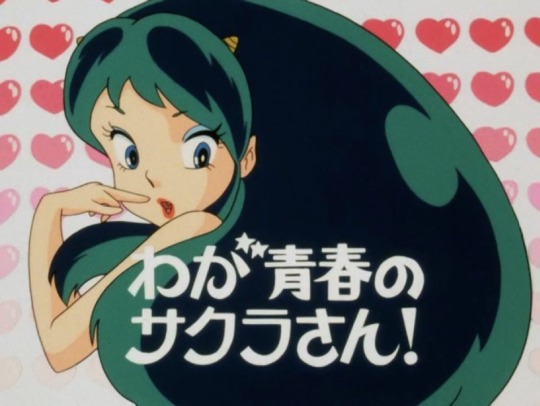
0 notes
Text
TIME of the SEASON Summer 2022 Edition: VERMEIL in Gold
Well, it's not an isekai but it is another cliche anime staple - the magical high school anime!
OK, from the looks of this and seeing this earlier, this one seems like an easy one to knock out of the park.
And kinda predictable, too.
This is Vermeil in Gold. And yes, I know it’s another long title. No, I’m not posting it.
Director: Takashi Naoya
Series Composition: Tatsuya Takahashi
Music:
Ken Itō
Kenichi Kuroda
Original creator:
Kōta Amana
Yōko Umezu
Character Design: Kiyoshi Tateishi
Art…
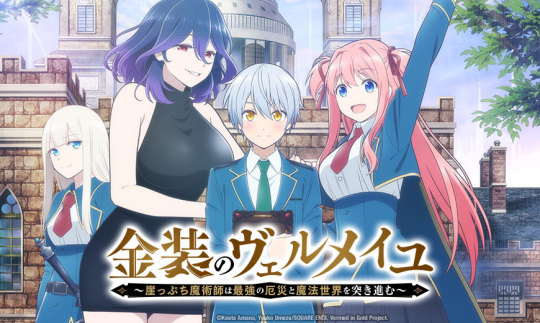
View On WordPress
#adventure#Anime#demons#first impression#HiDive#magic#rom-com#Sentai Filmworks#Staple Entertainment#Summer 2022#Time of the Season#Vermeil in Gold
1 note
·
View note
Photo
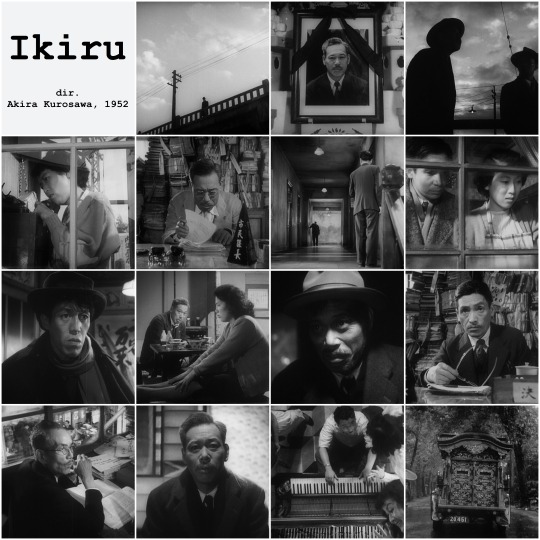
Ikiru
directed by Akira Kurosawa, 1952
#Ikiru#Akira Kurosawa#movie mosaics#Takashi Shimura#Miki Odagiri#Yūnosuke Itō#Kamatari Fujiwara#Minosuke Yamada
25 notes
·
View notes
Link
#ghidorah the three headed monster#film#review#criterion collection#godzilla#Ishirō honda#yōsuke natsuki#yuriko hoshi#hiroshi koizumi#akiko wakabayashi#emi itō#yumi itō#takashi shimura#akihiko hirata#hisaya itō
2 notes
·
View notes
Photo

Itō Takashi (Japanese ,1894-1982)
Takegawa river at dawn,1932
670 notes
·
View notes
Text


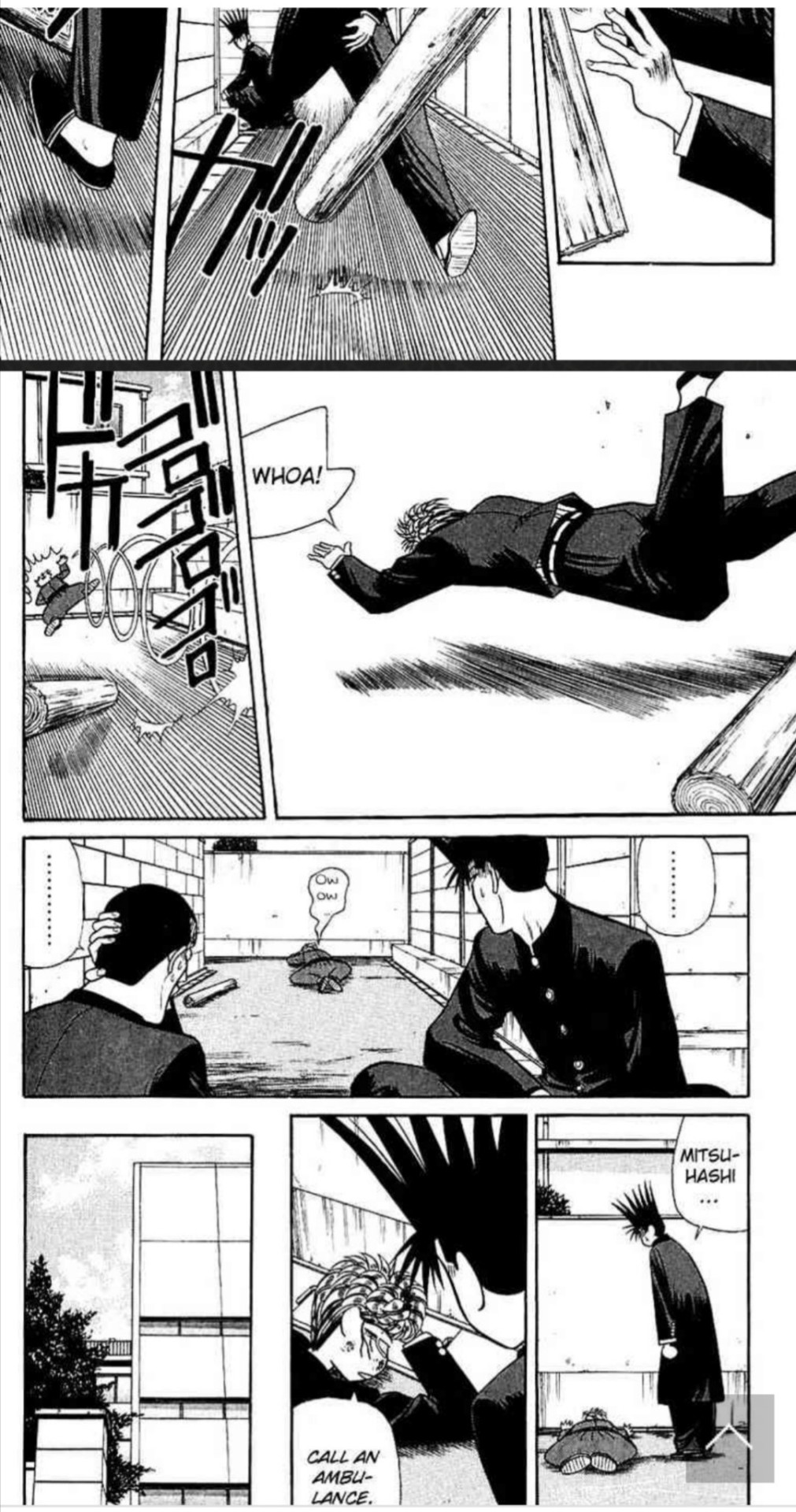


The only person who has ever taken out mitsuhashi is mitsuhashi
#mitsuhashi takashi#riko akasaka#from today on i am!!#kyou kara ore wa!!#ryō tanaka#itō shinji#katsutoshi imai#imai katsutoshi
27 notes
·
View notes
Text

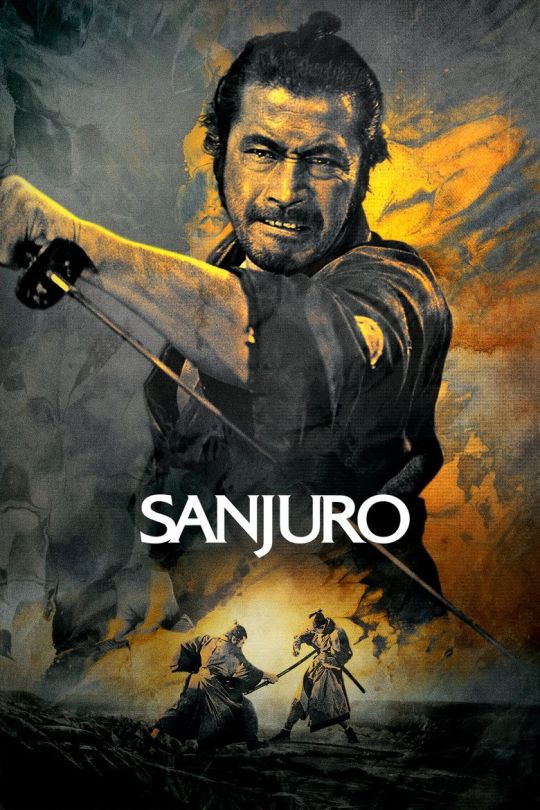

WATCHED
映画を見て
#Sanjuro#椿三十郎#Akira Kurosawa#Hibi Heian#Shugoro Yamamoto#Toshiro Mifune#Tatsuya Nakadai#Keiju Kobayashi#Yūzō Kayama#Reiko Dan#Takashi Shimura#Kamatari Fujiwara#Takako Irie#Masao Shimizu#Yūnosuke Itō#watching#jidaigeki#samurai#ronin
12 notes
·
View notes
Photo



Terra Formars
27 notes
·
View notes
Text
The Demon Girl Next Door Review

On July 1st, this supernatural slice-of-life comedy anime directed by Hiroaki Sakurai came to an end. This series, which recently concluded, is based on an ongoing six volume manga series by Izumo Itō of the same name.
Reprinted from Pop Culture Maniacs, my History Hermann WordPress blog on Feb. 7, 2023, and Wayback Machine. This was the twelfth article I wrote for Pop Culture Maniacs. This post was originally published on July 18, 2022. This article was originally supposed to be published on The Geekiary, but they rejected it, saying it was too similar to my previous review.
The Demon Girl Next Door tells the story of a demon girl, and her two magical girl companions, as they learn more about themselves and face unexpected challenges.
The last six episodes of this anime continue with the same levity as the first nineteen episodes, with continued comedic moments, especially when it comes to the relations between Shamiko (Konomi Kohara), also known as Yuko Yoshida, and two magical girls.
The latter have their own internal problems. Mikan Hinatsuki (Tomoyo Takayanagi) has a curse that causes others to experience calamities when she gets flustered. Momo Chiyoda (Akari Kitō) is on the precipice between the powers of light and dark.
Although Shamiko is similar to the protagonist of The Great Jahy Will Not Be Defeated!, Jahy, in that she lives in a run-down apartment, she isn't alone in this. Mikan and Momo move in next door, and they all live in the same apartment complex. None of them are well-off.
Shamiko also gains a support network, of sorts, apart from help the magical girls give her. She has school friends like Anri Sata (Sayaka Senbongi) and Sion Ogura (Ayaka Suwa). The latter is a lover of the occult. She is able to conjure up recipes to help Momo, especially to stop her from slipping to the dark side. Notes left behind by Sakura Chiyoda (Hisako Kanemoto), the elder adopted sister of Momo, and magical girl, who gave her energy to keep Shamiko alive, assist her in this endeavor.
In another similarity with Jahy, Shamiko works in a part time job. Unlike that series, in The Demon Girl Next Door the bar is staffed by two magical beings: a demon tapir named Shirosawa, and a Hula jing fox named Lico.
As it turns out, Shirosawa (Takashi Matsuyama), who runs the coffee shop. He even created the mascot of the shopping district when the cat form of Sakura inspired him. As for Lico (Ayasa Itō), she is a waitress at the shop and she often uses magical leaves to bewitch people who eat the food that she makes. This includes, at one point, Shamiko.
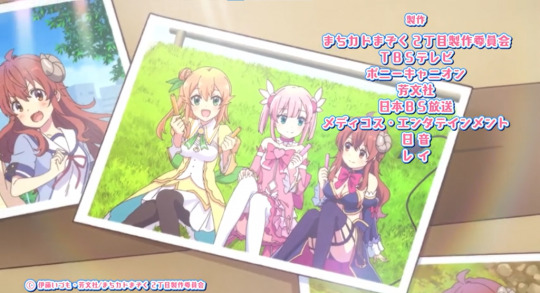
Similar to other series in Western animation, like Amphibia, The Owl House, Steven Universe, gen:LOCK, and Inside Job, memories, manipulation, and mindscapes are an important part of this series.
Part of this is shown in the fact that Lilith (Minami Takahashi), an ancestor of Shamiko, can appear in the dreams of Shamiko. She can even take over Shamiko's body if a switch is flipped on her statue.
Lilith often guides Shamiko and Momo, especially when they enter mindscapes. However, she can only be connected to such mindscapes for a short period of time, and her connection can get fuzzy at times.
Then, there's times when Shirosawa has psychedelic hallucinations caused by eating Lico's food. The same is the case for Shamiko.
In one episode, Shamiko and Ryo go into Lilith's dreamspace, discovering she has a lot of manifestations of her loneliness there. Ultimately, she ends up defeating them all by changing her magic rod into stuff from video games she likes.
The final episodes of the series focus on Momo and Shamiko going into the heart of Mikan, with help from Lilith. They vow to tell the protective demon inside Mikan, Ugullu (Fairouz Ai) to calm down and end her curse once and for all. They are able to successfully negotiate with Ugullu and get her to realize the damage she is causing.
In a nice end to the series, Mikan's school friends help her out, by coming late one night to summon Ugullu into a new body, and a dish made at the cafe Shamiko works at. Ugullu comes into a new form and Mikan accepts her as part of her family.
In a post-credit scene, Ugullu clear has found her place, coming to terms with her new identity outside of Mikan, no longer tasked with defending Mikan from evil.
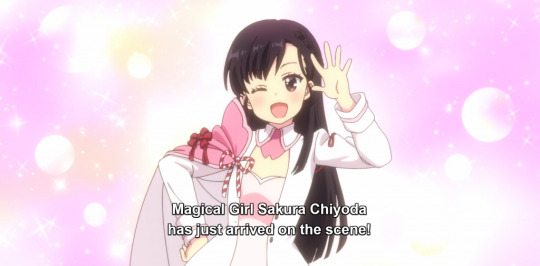
Like any other magical girl, or magical boy, series, magical transformations are a big part of the series. Similar to the aforementioned The Great Jahy, the magical girls and the demons can both transform. Shamiko can transform into the "crisis management form" which gives her some additional powers. In contrast, Momo and Mikan have their own specific magical girl forms.
At other points, Shamiko's sister Ryoko "Ryo" Yoshida (Hitomi Ōwada) helps create weapons with her magic rod. She realizes that Shamiko's subconscious is holding her back and helps her get over her mental hurdles. This is in-keeping with the series playing off many common elements of magical girls in anime and manga.
Unlike Mikan, Momo has a dark form which is known as "Darkness Peach". She occasionally transforms into this form when she is teetering on the edge of dark and light. At one point, she struggles to keep the two separated, but Shamiko helps her, as does Sion.
At another point, Shamiko tries to develop a special attack and inherits a wand from her father which can transform into anything she wants. She is helped in this task by Shamiko, and in coming up with a super special move. Both seem to have some feelings for each other.
There is also talk in the series as to how magical girls are ordinary girls who make a pact with the light clan, with demons getting a token for each magical girl they defeat. All the while, Shamiko often utters her line "don't think this means you've won". In a funny reference to this line, Momo says it at one point, almost becoming an in-joke of sorts.
Even worse is the fact that Momo's "Darkness Peach" form can break anything she touches. It turns out that when she is happy and content, the balance between the dark and light sides can come to a balance. She even goes to a hot healing spring said to be of therapeutic value, but it turns out to be a healing waterfall. What she finds there is turned into an elixir by Sion, which ends up helping her later on.
Related to this are the magic barriers put on doors, either with magic by Momo, Mikan, or Shamiko. Hilariously, these barriers are just weak pieces of paper, but apparently have all sorts of magical power.
In the final scene of the series, Ugullu declares that Shamiko is the boss of Momo, who is overjoyed. It ends with Momo teasing Shamiko, as they both walk off into the distance.
youtube
Since The Demon Girl Next Door is based on a manga parody series, it is no surprise that the series doesn't really take itself too seriously. The characters are never in series danger. Instead there are occasional breaks in the fourth wall. There's even a hilarious shirt worn by Lilith on multiple occasions which says "my blood sugar level is dangerous".
At other points there are faulty recaps which don't make sense and fun interplay between Momo and Shamiko. This involves Momo trying to motivate Shamiko to do homework and the fact that Momo wants to see a baby tiger at the zoo.
Also comedic is Momo's reaction when she drinks disgusting potions from Sion. At others, the characters are saying that they don't have many lines of dialogue or when Lilith tries to send a picture of herself into the camera but it doesn't work.
Its also funny how Mikan, who lives alone, is afraid of cockroaches even though she is an all-powerful magical girl. Shamiko helps her, even assisting in cleaning up her trash. It is a bit amazing that Shamiko, who has only known Momo for a few months, is able to help Mikan more than Momo, who has been a friend of Mikan for 10 years.
In some ways, Mikan is socially awkward. In the show's next to last episode, she worries about her school introduction as a transfer student. It ends up going well, however, with Anri helping her. She ropes in Momo to help with prepare with sports day preparations.
Family is an important theme in The Demon Girl Next Door too. Shamiko has a tight family, with a loving sister, Ryo, and mother, Seiko Yoshida (Sayaka Ohara). She has a smile on her face, no matter how absurd the situation is. In an interesting twist, Joshua (Hideyuki Umezu), the father of Ryo and Shamiko, was sealed in a cardboard box by Sakura, the same box they eat many meals on!
Family is important to Momo too. She deals with the past actions of her sister and tries to figure out why she did what she did. She and Mikan find a chosen family among Shamiko, her family, and many school friends.
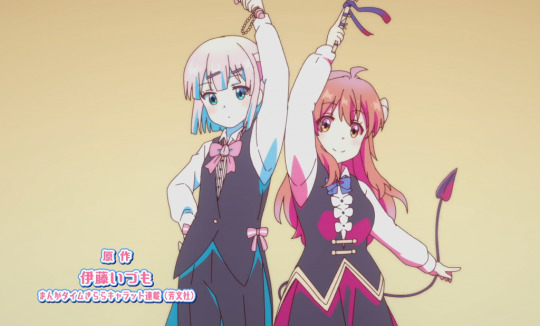
While some have argued that the series is a "mid-tier offering" with animators told to not "overtax their assets", the series has a certain charm to it. This is due to the fact that J.C. Staff, responsible for recently ended The Executioner and Her Way of Life, and series such as Edens Zero, Sweet Blue Flowers, R.O.D.-The TV, Azumanga Daioh, and Revolutionary Girl Utena, animated this series. While the animation of this series does not have the same quality as the aforementioned series, it still fits with the slice-of-life vibe.
The show's voice actors have voiced characters in series ranging from Bloom Into You to Akebi's Sailor Uniform. Many of these series, and others, like Adachi and Shimamura, Asteroid in Love, Kageki Shojo!!, have direct and indirect yuri themes.
Others are about socially awkward characters, like Hitori Bocchi no Marumaru Seikatsu and Komi Can't Communicate. This undoubtedly set the groundwork for their voice acting in this series. The same can be said for those who voiced characters in slice-of-life series like Chronicles of the Going Home Club, Kin-iro Mosaic, Gabriel DropOut, and Let's Make a Mug Too.
I loved that some of the voice actors in this series voiced characters in Bodacious Space Pirates. The latter is a niche sci-fi adventure anime which has two supporting characters (Lynn Lambretta and Jenny Dolittle) in a romantic relationship.
The series director, Hiroaki Sakurai, is just as talented. He is known for directing comedies like Kodocha, Di Gi Charat, Di Gi Charat Nyo!, and Nanaka 6/17. He also directed a ninja anime, Jubei-chan: The Ninja Girl, and a magical girl parody, Majokko Tsukune-chan. This directing experience, and that of other series, undoubtedly had a positive impact on The Demon Girl Next Door.
While the final episode of the series is a fitting season end, there is a possibility for continuation. A third season could be focused on the continued adventures of Mikan, Momo, and Shamiko. Another season would continue to be slice of life, with a continued focus on trying to make the town a place that's easy for everyone to live in as the narrator says at the end.
Perhaps even Momo and Shamiko could be shown as more than ambiguously together. They could be even closer like the protagonists of Miss Kobayashi's Dragon Maid, Kobayashi and Tohru. It could be more than "shipping fodder" between them then, with often fanservicey outfits of Momo, Shamiko, and other characters. This series does not have any explicit queer representation, just heavy subtext.
In the end, while The Demon Girl Next Door is not my favorite anime series that I've watched this year, it is still a must-see for those interested in magical girls, demons, supernatural themes, and yuri subtext.
The Demon Girl Next Door can be watched on HIDIVE.
© 2022-2023 Burkely Hermann. All rights reserved.
#the demon girl next door#yuri#anime#manga#lgbtq#reviews#pop culture#magical girls#the great jahy will not be defeated#magical transformation#hidive#miss kobayashi's dragon maid#fan service#Youtube
3 notes
·
View notes
Photo
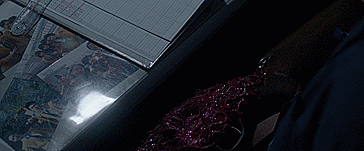
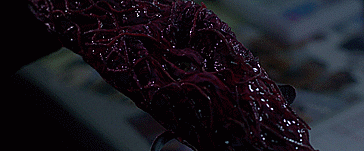
Lesson of the Evil - Takashi Miike 2012
207 notes
·
View notes